There was a huge amount of interest in sharing details of AI tools in our last HE Community session.
We’ve given some thought to how we might best do that in a way that is both useful but also achievable.
There are lots of directories of AI tools and we don’t want to try and compete or replicate that. We think the value is understanding how people are using them. So we are going to focus on sharing details of AI tools and features that we hear people are using and link to any story or information about how. Defining ‘AI tools’ is getting increasingly hard, as AI is built into more and more tools, hence the mention of both ‘tools’ and ‘features’ – the latter which might be in any application.
We are going to do a very light first draft as a blog post, based on the recent community event and other recent events to get feedback, and will then take it from there. At this point, we aren’t going to overthink the categorisation (we could spend ages down that rabbit hole!).
This listing includes contributions from across the AI team.
Version 1.1 – 11th Sept 2024. First version published in August 2024
Version 1.2 – 14th Oct 2024. First version published in August 2024
Version 1.3 – 30th Oct 2024. First version published in August 2024
Version 1.4 – 26th Nov 2024. First version published in August 2024
Version 1.5 – 20th Dec 2024. First version published in August 2024
Version 1.6 – 10 Jan 2025. First version published in August 2024
Version 1.7 – 03 Feb 2025. First version published in August 2024
Michael Webb
General Chatbots and Assistants
General Chatbots and Assistants
ChatGPT
Description: The original general-purpose generative AI chatbot.

Getting Started: Go to the ChatGPT website to create an account. There is no cost for the basic version.
Examples of use:
- Creating Essay Plans – North West Regional College
- Create Multiple Choice Quizzes – New College Durham
- Lesson Plan Generation – New College Durham
- Building Games – Cardiff University
- ChatGPT: Business Development Team – Coleg Sir Gar
- Case Study Generation – Coleg Sir Gar
- Pioneer Video – Innovative Drama Teaching with AI – Coleg Sir Gar
- Generating Podcasts and Interactive Slides – Coleg Sir Gar
- Navigating Excel with a Gen AI Tutor – Jisc
- Embracing Generative AI in Fashion Education – University of Northampton
- ChatGPT as a legal review tool – Jisc
- An Introduction to Using ChatGPT Plus for Image Generation – Jisc
Key Information:
- Cost: Free basic plan, with a subscription available for $20/pm
- Enterprise version available? Yes
- Privacy and IPR statement? Yes, see the OpenAI privacy policy for details
- GDPR statement? Yes, covered in the OpenAI privacy policy
- Accessibility statement or guidance? No
- Age Restrictions: 13+ with parental consent
- Tried by Jisc’s AI Team? Yes, used extensively by the team and mentioned in our Generative AI Primer by Michael Webb.
(Entry created 28 August 2024. updated 3o October 2024)
Claude
Description: Claude is an AI chatbot from Anthropic, that is built on multiple models, currently running on Claude 3.5 (Sonnet). It is built to be a responsible AI with strong ethical principles. It can be used for analysis, writing, maths, coding and other projects.
Getting Started: Go to the Claude website, create an account and you will be able to start interacting with Claude.
Examples of use:
- None currently – we’d love submissions of examples.
Key Information
- Cost: Free basic plan, with a subscription available for £18/pm
- Enterprise version available? Yes, see Claude’s upgrade pricing for details
- Privacy and IPR statement? Yes, see Anthropic’s Privacy Policy
- GDPR statement? Yes, included in Anthropic’s Privacy Policy
- Accessibility statement or guidance? No
- Age Restrictions: 18+
- Tried by Jisc’s AI Team? Yes, used extensively by the team and mentioned in our Generative AI Primer by Michael Webb
(Entry created 28 August 2024. updated 3o October 2024)
Google Gemini
Description: Google Gemini is a family of multimodal large language models developed by Google DeepMind, serving as the successor to LaMDA and PaLM 2. Comprising the Gemini Ultra, Gemini Pro, Gemini Flash, and Gemini Nano models.
Getting Started: To get started with Gemini, just go to the Gemini website where users will have access to the Gemini 1.5 Flash model. To use Gemini Advanced, you will need to subscribe to Google One for access
Examples of use:
- Empowering Educators by Harnessing Generative AI Tools: How to use Google Gemini – Jisc
- Google Gemini for Active Learning and Explorations – University of Sheffield
- Enhancing Feedback with Generative AI – University of Sheffield
- Navigating Excel with a Gen AI Tutor – Jisc
Key Information:
- Cost: Free version with paid version from £18.99 a month
- Enterprise version available? Yes
- Privacy and IPR statement? Yes, see Google Apps privacy notice
- GDPR statement? Yes, included Google Apps privacy notice
- Accessibility statement or guidance? See the Google admin guide to accessibility and more accessibility guidance pages
- Age Restrictions: 13+ – see Gemini FAQs for details
- Tried by Jisc’s AI Team? Yes, tested out features available in the UK, which don’t include image generation presently, but otherwise tested extensively.
(Entry created 28 August 2024)
(Updated 28 Feb 2024)
LearnWise
Description: AI-powered university companion, for streamlining access to support services.
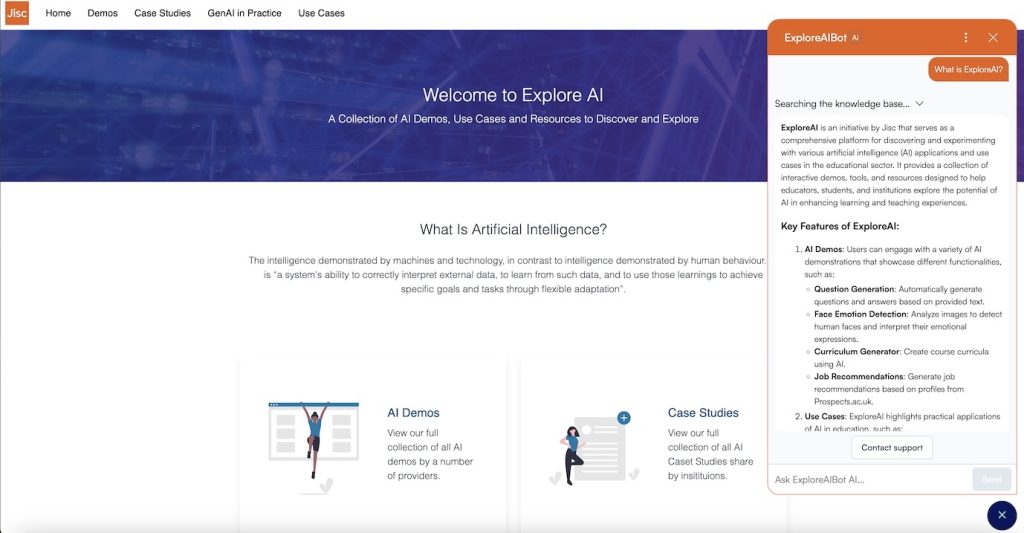
Getting Started: To get started, you can book a demo with LearnWise.
Examples of use:
Key Information
- Cost: Flexible – varies with use cases.
- Enterprise version available? Yes
- Privacy and IPR statement? Yes, see the Learnwise privacy policy for details
- GDPR statement? Yes, EU based company
- Accessibility statement or guidance: No
- Age Restrictions: 18+ or under with parental consent Learnwise Terms and Conditions.
- Tried by Jisc AI Team? Yes – tested extensively and moving to pilot.
(Entry created 28 August 2024. updated 3o October 2024)
Microsoft Copilot (Web)
Description: Microsoft Copilot is a generative artificial intelligence chatbot developed by Microsoft, it is the evolution of the Bing Chat app. Based on the large language model GPT-4 from OpenAI, it is a chat tool focused on searching for information from the internet and can generate images. It does not have access to organisational resources within Microsoft 365.
Getting Started: To create a Copilot account, go to the Copilot website.
Examples of use
- Creative Prompts for Dynamic Educational Discussions – Regent’s University London
- Creating Pro/Cons Lists – Regent’s University London
Key Information:
- Cost: Free
- Enterprise version available? Yes
- Privacy and IPR statement? Yes, see the Microsoft privacy statement for details
- GDPR statement? Yes, see the Microsoft privacy statement for details
- Accessibility statement or guidance: Yes, see Microsoft accessibility resources
- Age Restrictions: 18+, see Microsoft’s information around use of Copilot in Education
- Tried by Jisc’s AI Team? Yes
(Entry created 28 August 2024)
Microsoft Copilot 365
Description: Microsoft Copilot is a generative artificial intelligence chatbot developed by Microsoft. Based on the large language model GPT-4 from OpenAI, these are a set of generative AI tools for Microsoft 365 (i.e. Word, Excel, PowerPoint etc).
Getting Started: To create a Copilot account, go to the Copilot website, note that Copilot 365 is available as an add-on to Microsoft 365 and requires a Microsoft 365 subscription to purchase.
Examples of use:
- Initial thoughts on Microsoft Copilot for 365 (and AI FOMO) – Jisc
- Copilot 365 Teams meeting summary – Jisc
Key Information:
- Cost: $20 a month
- Enterprise version available? Yes, see Copilot 365 pricing page
- Privacy and IPR statement? Yes, see the Microsoft privacy statement
- GDPR statement? Yes, see the Microsoft privacy statement for details
- Accessibility statement or guidance: Yes, see Microsoft accessibility resources
- Age Restrictions: 18+, see Microsoft’s information around use of Copilot in Education
- Tried by Jisc’s AI Team? Yes
(Entry created 28 August 2024)
Mistral (Le Chat)
Description: Le Chat is an AI assistant created by French company Mistral AI, designed to answer questions and help with code creation, language translation and learning. It has three main modes, Canvas, Web access for searches and is also capable of Image generation, image descriptions and caption creation.
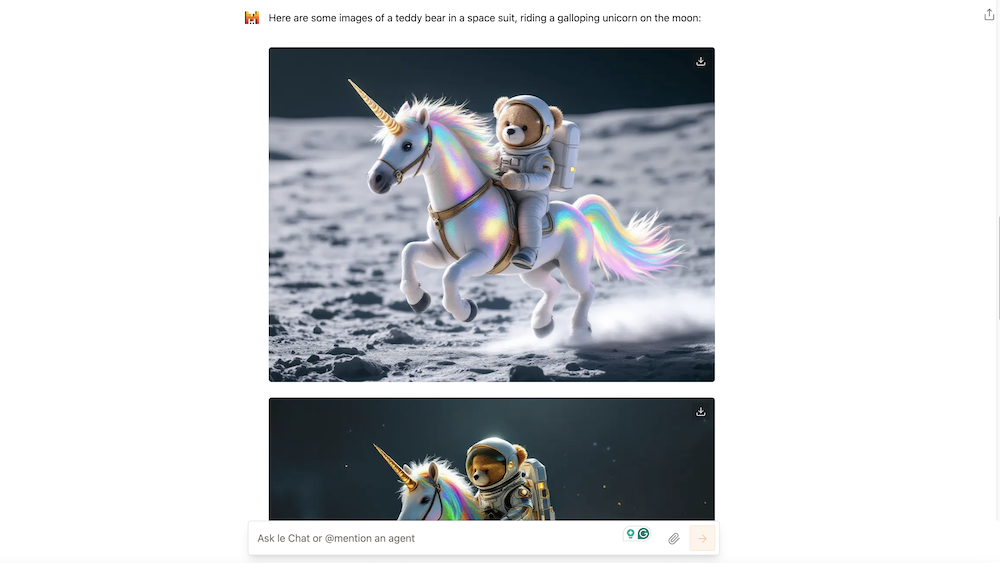
Getting Started: To get started with Le Chat, head to Mistrals Le Chat, create an account and start a conversation, you can toggle Canvas, Web Search & Image Generation on or off as you need.
Examples of use: None currently – we’d love submissions of examples.
Key Information:
- Cost: It is free to use Le Chat, and pricing to build with Mistrals models can be found here (Pricing)
- Enterprise version available? Used by a variety of businesses, but costing depends on use-case.
- Privacy and IPR: Yes, Mistrals Privacy Policy
- GDPR statement? Yes, Data Processing Agreement
- Accessibility statement or guidance:No
- Age Restrictions: 13 years + as per Mistrals Terms of Use
- AI Team? Yes, we have been testing Mistral since its launch and its outputs are very impressive.
(Entry created 26 November 2024)
Poe
Description: Poe is a platform of AI-powered bots, powered by models from several sources, trained by different companies such as OpenAI, Anthropic, Google & Meta.
Getting Started: Free bot access & creation, with daily limits on use. Certain models are for paid subscribers only.
Examples of use:
- Custom Chatbot for Course Questions – University of the West of England
Key information:
- Cost: Free, paid version £16.67pm/£199.99pa
- Enterprise version available? No
- Privacy and IPR statement? See the Poe privacy policy for details
- GDPR statement? Yes, via standard contractual clauses.
- Accessibility statement or guidance? No
- Age Restrictions: Over 13 with parental consent.
- Tried by Jisc’s AI Team? Yes, used to create widely shareable bots allowing for access to models.
(Entry created 28 August 2024)
Raffle AI
Description: Raffle is an AI-powered search engine that helps organisations access information by integrating with internal systems and using natural language processing and vector search to resolve queries. There is an AI chat as well but for the demo, it was only AI search available.
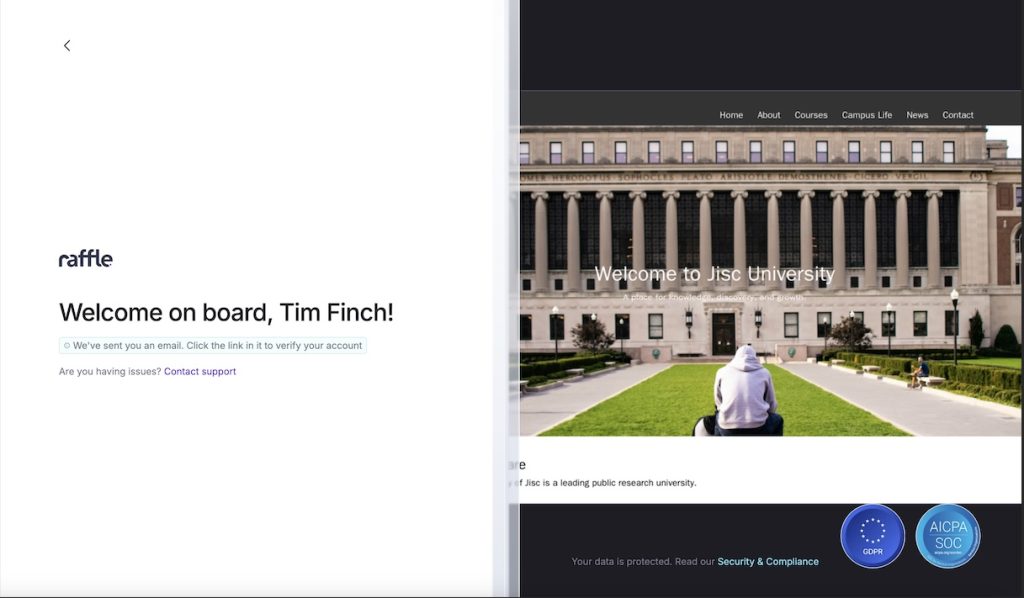
Getting Started: to get started with Raffle you will need to provide the URL that you want the bot trained on. From there you can sign up for a 7-day free trial and get started with their chatbot. More info is available at Raffle AI Start Guide.
Examples of use: None currently – we’d love submissions of examples.
Key Information:
- Cost: Free 7-day demo. Costs are not available but seem to be something that comes after a demo call. See Raffle AI pricing.
- Enterprise version available? Yes, seems to be available after demo call.
- Privacy and IPR: Yes, see the Raffle AI Privacy policy
- GDPR statement? Yes, see the Raffle AI Privacy products page
- Accessibility statement or guidance: Yes, see the Raffle AI Accessibility page
- Age Restrictions: None listed in terms and conditions.
- AI Team? Yes, tested thoroughly on the trial, implemented on a tester site and works well for retrieving pages based on queries. Note that the trial does not allow for integration of the system, just testing the trained materials on their platform.
(Entry created 30 October 2024)
Image Creation
Adobe Firefly
Description: Adobes text to image generation tool, built on their proprietary AI model.
Getting Started: Easy to start, just create an Adobe account and access the free plan.
Examples of Use:
Key Information:
- Cost: 25 Free credits per month, Firefly Premium Plan is £4.49pm the Adobe Express plan starts at £9.98/mo incl. VAT
- Enterprise version available? Yes
- Privacy and IPR statement? Yes, see Adobe’s privacy policy and a recent clarification
- GDPR statement? Yes, see Adobe’s extensive GDPR information
- Accessibility statement or guidance: Yes, see Adobe’s Accessibility pages
- Age Restrictions: 5 years + Adobe Firefly K-12
- Tried by Jisc’s AI Team? Yes, tested extensively and used by the team for some content generation and as a candidate for a future pilot.
(Entry created 28 August 2024. updated 30 October 2024)
Lexica AI
Description: Lexica AI is used for AI-driven image generation based on text prompts. It is primarily aimed at graphic designers, content creators, marketers, and educators. It works on a Stable Diffusion model.
Getting Started: go to Lexica AI and login, there is a limited free tier which users can use to explore the platform.

Examples of use: None currently – we’d love submissions of examples.
Key Information:
- Cost: Starter ($10/month), Pro ($30/month), and Max ($60/month)
- Enterprise version available? No.
- Privacy and IPR: No.
- GDPR statement? No.
- Accessibility statement or guidance: No.
- Age Restrictions: None found.
- AI Team? Yes, and was found to be an effective image-generation platform.
(entry created 20 January 2025)
Midjourney
Description: Image generation platform using custom model, text to image only.
Getting Started: Image generation platform using a custom model, text to image. Midjourney includes an image editor that lets you revise prompts, modify specific areas of an image, edit, and add new elements.
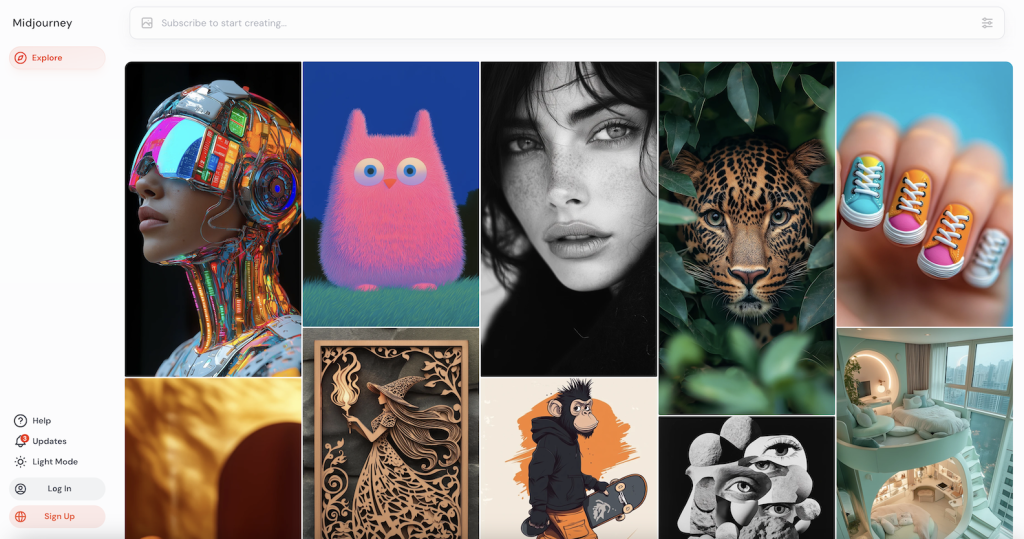
Examples of Use:
- None currently – we’d love submissions of examples.
Key Information:
- Cost: $10 pm basic plan, $30 pm for a standard plan
- Enterprise version available? No
- Privacy and IPR statement? Yes, see Midjourney’s privacy policy
- GDPR statement? Yes, see clause 6 of Midjourney’s privacy policy
- Accessibility statement or guidance: No
- Age Restrictions: 13+ and meet the age of digital consent in the country of usage, see clause 3 of Midjourney’s privacy policy for details
- Tried by Jisc’s AI Team? Yes, tested out on Discord by the team
(Entry created 28 August 2024)
Learning and Teaching
Anywyse
Description: Platform that uses generative AI to allow educators to create short podcast-style learning resources.
Getting Started: Start a free trial through the AnyWyse website.
Examples of use:
Key Information:
- Cost: Contact AnyWyse or Jisc Licensing for pricing
- Enterprise version available? Yes
- Privacy and IPR statement?: Yes, see AnyWyse Privacy Policy
- GDPR statement? Yes, included in AnyWyse Privacy Policy
- Accessibility statement or guidance: No statement on AnyWyse itself, some information on using AnyWyse as an accessibility tool is available
- Age Restrictions: None
- Tried by Jisc’s AI Team? Yes piloted.
(Entry created 28 August 2024. updated 3o October 2024)
Bodyswaps
Description: A skills training platform, using VR to create the environments for participants, and with AI-powered analysis to give feedback on a user’s performance.
Getting Started: To get started, you can book a demo with Bodyswaps.

Examples of use:
- Bodyswaps pilot report – Jisc
Key Information:
- Cost: Flexible – varies with use cases. Available through Jisc licensing, see subscriptions manager for details.
- Enterprise version available? Yes
- Privacy and IPR statement? Yes, see Bodyswap’s privacy policy
- GDPR statement? Yes
- Accessibility statement or guidance: Yes, see Bodyswap’s accessibility statement
- Age Restrictions: None
- Tried by Jisc’s AI Team? Yes- tested extensively, and successfully taken to pilot.
(Entry created 28 August 2024)
Blackboard – AI Design Assistant
Description: Blackboards AI Design Assistant is a tool aimed at educators to help create learning modules, make rubrics, create question banks, and design assessments for all levels of education. More information on the Design Assistant is available here: Blackboard AI Assistant.
Getting Started: Go to Anthology website and sign up for a 30-day free trial.
Examples of use: Yes, case study here: Case Study Blackboard
Key Information:
- Cost: Available upon request.
- Enterprise version available? Yes.
- Privacy and IPR: Yes, see the Anthology Data Privacy policy
- GDPR statement? Yes, see the Anthology Data Privacy policy
- Accessibility statement or guidance: Yes, see the Accessibility page
- Age Restrictions: None, more info on data collection and use is available here: Privacy statement
- AI Team? Yes, demo tried and several members of the team have used it previously. Also, a Case study of use from members is available here: Case Study Blackboard
(Entry created 14 October 2024)
FeedBack Fruits
Description: An AI platform that aims to improve students’ academic and professional writing styles by automating feedback on structural elements like citation, academic style, grammar, and structure.
Getting Started: Book a demo through the FeedbackFruits website.
Examples of use:
Key Information:
- Cost: Pricing on application
- Enterprise version available?
- Privacy and IPR statement? Yes, see the FeedbackFruits Privacy policy
- GDPR statement? Yes, see the FeedbackFruits Privacy policy
- Accessibility statement or guidance: Yes, see FeedbackFruits Accessibility: WCAG Compliance page
- Age Restrictions: 18+ for US
- Tried by Jisc’s AI Team? Piloted by Jisc AI Team
(Entry created 28 August 2024)
Graide
Description: AI-powered teaching assistant, with an emphasis on reducing workload by utilising AI to assist in essay grading.
Getting Started: Request a demo on the Graide website
Examples of use:
- Graide pilot overview – Jisc
Key Information
- Cost: Pricing available on request
- Enterprise version available? Yes, institutional licenses are offered – pricing available on request.
- Privacy and IPR statement? Yes, see the Graide privacy policy
- GDPR statement? Yes, covered in the Graide privacy policy
- Accessibility statement or guidance: No
- Age Restrictions: No mention on site but is aimed at use in universities.
- Tried by Jisc’s AI Team? Yes, successfully piloted
(Entry created 28 August 2024)
Jamworks
Description: Jamworks is a powerful AI note-taking and revision tool that automatically turns lectures into useful study materials – such as well-organised text notes, video chapters, interactive flashcards and personalised AI chatbots.
Getting Started: Get started with a free trial or book a demo through the Jamworks website.
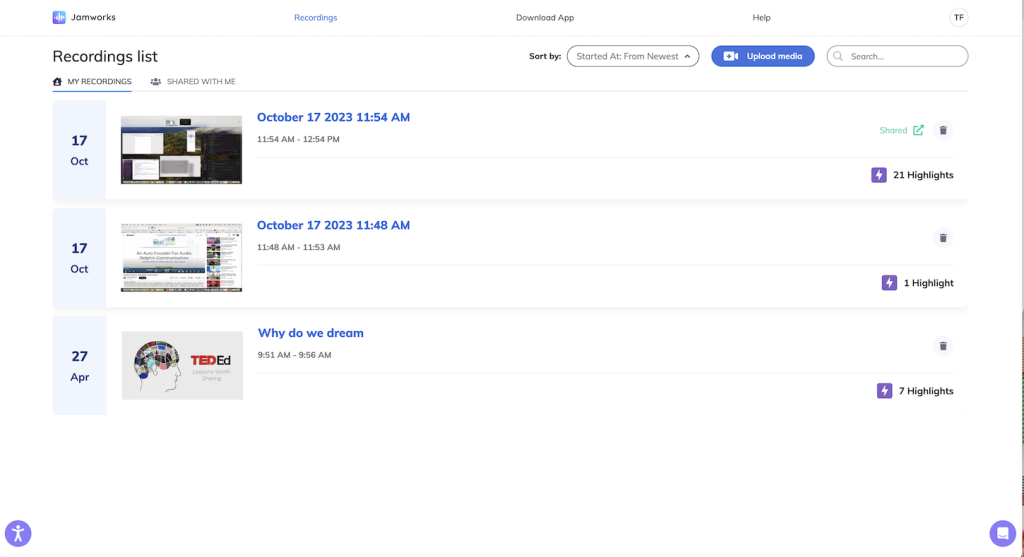
Examples of use:
- Jamworks Pilot Launch – Jisc
Cost:
- Enterprise version available? Yes, contact Jamworks for institutional pricing
- Privacy and IPR statement? Yes, see Jamworks privacy policy
- GDPR statement? Yes, included in Jamworks privacy policy
- Accessibility statement or guidance: Yes, view the full Jamworks accessibility statement
- Age Restrictions: 16+
- Tried by Jisc’s AI Team? Yes, taken to pilot, which is currently running
(Entry created 28 August 2024. updated 3o October 2024)
Keath AI
Description: Keath.ai is a generative AI platform that provides feedback on students’ essays, reports and dissertations. Educators can train their own version of Keath’s AI model, meaning that the platform is sensitive to specific assessment rubrics and how they are interpreted in practice. The training process requires as few as ten essays to be manually graded against the specified rubric. With Keath.ai, educators are also able to review and amend the platform’s feedback. Keath.ai intends to act as a digital marking assistant – not to replace human markers. This is emphasised by Keath’s human-in-the-loop model, which requires human input to confirm feedback and marks provided by the system.
Getting Started: If you go onto Keath AI Website and click ‘Try Keath’ you’ll be able to test out Keath using a test file to see how the AI grades and provides feedback on a variety of different assignment types – essays, reports, dissertations and even EPQs.
As you’ll see, feedback is broken down into knowledge, independent study, development of argument, application, and transferable skills – with each of these sections being marked out of 20. The final score is given out of 100.
Please note that this demo environment uses basic rubrics. The demo does not allow you to customise rubrics, but the full version does have this capability, allowing the upload of mark schemes for additional ease of use.
Examples of use:
- ai is being piloted in over 20 institutions globally, including UK universities.
- We’d love submissions of examples.
Key Information:
- Cost: Costs vary based on the extent of use. Currently, there is a one-time training cost of £300 per module for universities and an annual usage fee of £300 for up to 100 students across 3 assessments within a module. For universities, Keath.ai runs a free trial of up to 10 modules (including training and usage) and they then offer a paid pilot of up to 50 modules at a 50% discount with unlimited training.
- Enterprise version available? See above
- Privacy and IPR: Yes, Keath Privacy Policy here and notes on IPR can be found in their Terms of Service
- GDPR statement? Yes, see Keath Privacy Policy
- Accessibility statement or guidance: Yes see Keath Accessibility Statement
- Age Restrictions: Intended for use by educators
- AI Team? Yes, Jisc has used the demo environment version and has had a full demonstration of Keath AI
(Entry created 30 October 2024)
Taskbase
Description: Taskbase is an assessment tool that uses AI to automate aspects of grading and feedback. Utilising AI, the platform evaluates students’ work with respect to pre-defined criteria, set by the teacher. It then provides students with personalised feedback, supporting students to improve and grow.
The platform is also able to generate exercises for students, based on their needs. It can be integrated with Learning Management Systems, such as Moodle and Canvas.
Getting Started: You can request a demo via their website
Examples of use: Jisc has spoken to colleagues in the further education sector who have trialled Taskbase on a limited basis, for giving feedback on student essays. The initial outcomes were positive.
Key Information
- Cost: Taskbase offers 3 tiers of usage: Small, Medium, and Enterprise. Please inquire for more details on pricing
- Privacy Policy and IPR statement? Yes, see their Privacy policy
- GDPR statement? Yes, see the Privacy policy
- Accessibility statement or guidance: No
- Age Restrictions: No age limits are imposed by Taskbase, however, they suggest that the tool is more suitable for use by learners above the age of 10
- Tried by Jisc’s AI Team? Jisc has received a demo of the platform, and has plans to explore the platform in more depth (we’ll update this page when we have further insights). We were impressed by the personalied feedback on assessments and look forward to conducting further investigations.
(Entry created 18 November 2024)
TeacherMatic
Description: AI platform for teachers, uses content generation tools to create lesson plans, rubrics, schemes of work and more to save educators time.
Getting Started: Register for a free demo at their website.
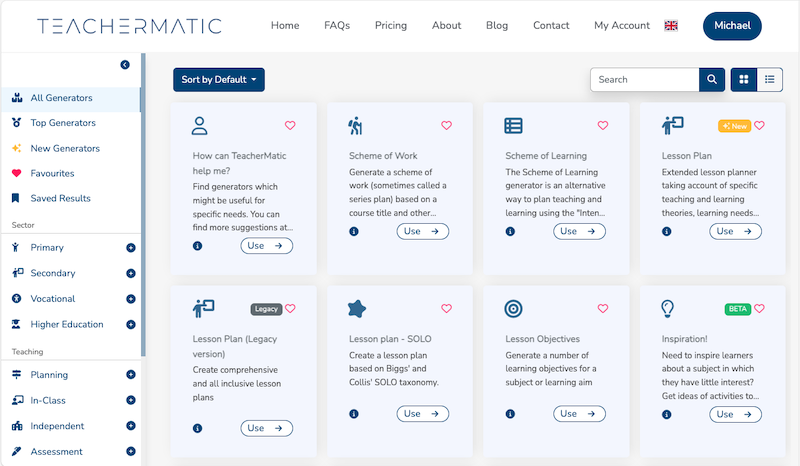
Examples of use:
- Teachermatic FE Pilot Report – Jisc
- Teachermatic HE Pilot Report – Jisc
- Teachermatic FE Pilot – An Overview of Generating Resources Using Generative AI in Further Education – Jisc
- Teachermatic HE Pilot – Using Teachermatic in the Higher Education Space – Jisc
Key Information
- Cost: £99pa for standard, £180 for professional, see TeacherMatic full pricing information
- Enterprise version available? Yes, organisational licenses are available.
- Privacy and IPR statement? Yes, see TeacherMatic Privacy Policy
- GDPR statement? Yes, included in the TeacherMatic Privacy Policy
- Accessibility statement or guidance: No statement, but tools include accessibility features such as ‘Learning Needs’ specifier to their lesson plan generator.
- Age Restrictions: None
- Tried by Jisc’s AI Team? Yes- tested extensively and taken to pilot.
(Entry created 28 August 2024, updated 30 October 2024)
Tutello
Description: Tutello combines human and AI support for tutoring by using an educator-curated knowledge base to answer student questions, directing them to tutors when needed. It offers analytics to track learning progress and integrates with multiple learning systems while ensuring data privacy and reducing AI errors.
Getting Started: You can request a demo on the Tutello website.
Examples of use:
- Tutello Product Notes – Jisc
Key Information
- Cost: Varies based on usage requirements but more information is available upon request from Tutello
- Enterprise version available? Yes, the team at Tutello are open to discussing how they can meet your usage requirements
- Privacy and IPR statement? Yes, see Tutello Privacy Policy
- GDPR statement? Yes, included in the Tutello Privacy Policy
- Accessibility statement or guidance: This is in the process of being produced (we’ll provide a link here when it has been completed)
- Age Restrictions: Tutello doesn’t currently have predefined age restrictions. Instead, they work with each institution to identify the student audience and implement appropriate safeguards or features based on their specific needs.
- Tried by Jisc’s AI Team? Yes. Jisc AI has explored using the platform from the perspective of both students and educators. Our explorations focused on content related to AI and education technology, and calculus. You can find out more about this in our Product Note
(Entry created 10 September 2024)
Content Creation
Bril AI
Description: Bril AI is an AI-powered tutor that creates personalised video courses on different topics using AI. It uses GPT4 to generate these courses and can take prompts based on specific learning goals. It comes complete with quizzes to test the user’s knowledge.
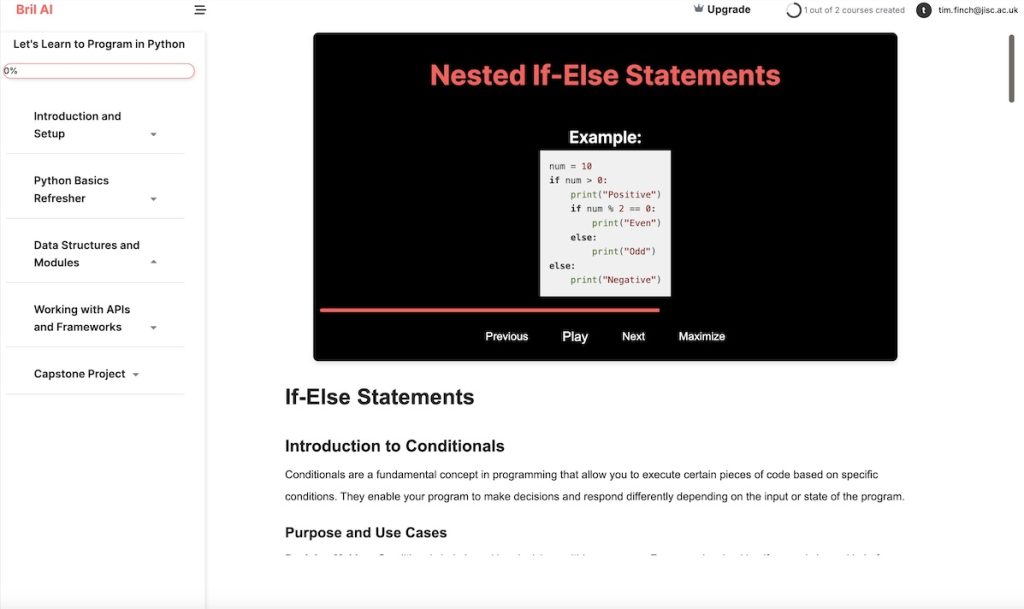
Getting Started: There is a free plan available with limited usage, just go to Bril AI Signup to get started.
Examples of use: None currently – we’d love submissions of examples.
Key Information:
- Cost: Free plan available, the Basic plan is $23.99 per month and the Premium is $39.99 per month.
- Enterprise version available?
- Privacy and IPR: Yes, see the Bril AI Privacy policy
- GDPR statement? Yes, see the Bril AI Privacy policy
- Accessibility statement or guidance: No
- Age Restrictions: 13 years +
- AI Team? Yes, a very useful tool for creating personalised content for specific subjects.
(Entry created 30 October 2024)
Canva
Description: Canva is a free-to-use graphic design platform that provides tools for creating social media graphics, presentations, promotional merchandise and websites.
Getting Started: Go to Canva and create an account to get started.
Examples of use:
- Mentioned here by Jisc AI in this article: Considering Image Generation and Education Today
- An Introduction to using Canva for Image Generation – Jisc
Key Information:
- Cost: Free to get started and also free for Education users.
- Enterprise version available? Yes information on the Enterprise pricing, but also note that Canva for education is free for students and teachers in eligible schools. more information is available at Canva for Education
- Privacy and IPR: Yes, here is Canvas Privacy Policy, also this statement around AI use Canva AI Product Terms
- GDPR statement? Yes
- Accessibility statement or guidance: Yes, here is the statement on Design Accessibility
- Age Restrictions: 13 years +
- Tried by Jisc’s AI Team? Yes, used to quickly and easily create a range of presentations for internal use.
(Entry created 28 August 2024)
Elevenlabs
Description: Generative voice AI including voice cloning and video dubbing.
Getting Started: Free trial for existing voices but requires payment for voice cloning.
Examples of use:
- Voice cloning, AI twins and deepfakes: threat or useful tool? Or both? – Michael Webb (Jisc) March 2024
- Revision Podcasts (Newcastle University)
Key Information:
- Cost: From $5 a month.
- Enterprise version available? Yes – price on application.
- Privacy and IPR: Yes, see ElevenLabs Privacy Policy
- GDPR statement? Yes
- Accessibility statement or guidance: No statement about ElevenLabs itself, but they do advise on using ElevenLabs to enhance accessibility
- Age Restrictions: Over 18s only
- Tried by Jisc’s AI Team? Yes, extremely effective at voice cloning and dubbing, so great if you want to show an example of this technology.
(Entry created 28 August 2024)
Gamma
Description: Presentation Creation Software
Getting Started: Free trial with a set number of credits.
Examples of use:
- A demo given at Networkshop 24. (Jisc)
Key Information:
- Cost: From $10 a month.
- Enterprise version available? No
- Privacy and IPR statement? Yes, see Gamma’s Privacy Policy
- GDPR statement? Covered in Gamma’s Privacy Policy see ‘Additional information for UK and EEA users’
- Accessibility statement or guidance: No
- Age Restrictions: Over 18s only
- Tried by Jisc’s AI Team Yes, it is an excellent tool, particularly when you provide it with material to base the presentation on.
(Entry created 28 August 2024)
Github Copilot
Description: AI pair programmer, suggesting code completions and using natural language prompts to generate code. It also explains code and is capable of writing documentation.
Getting Started: Create a GitHub account and go to the copilot page to get started on the free tier.
Examples of Use:
- None currently – we’d love submissions of examples.
Key Information:
- Cost: Individual paid accounts are $10 per month. Free subscriptions are available to verified students and Educators. GitHub now has a free tier available to users.
- Enterprise version available? Yes
- Privacy and IPR statement? Yes, see the GitHub’s privacy statement
- GDPR statement? Yes, covered in GitHub’s privacy statement
- Accessibility statement or guidance: Yes, see the GitHub accessibility statement
- Age Restrictions: 13 yrs +, see GitHub terms of service for more details
- Tried by Jisc AI Team? Yes, tested by AI team and licensed by Jisc for use in Jisc’s Developer teams.
(Entry created 28 August 2024, Updated 20 December 2024)
Google Notebook LM
Description: Notebook LM is a personalised research assistant from Google, capable of taking complex topics and converting them into ‘Podcasts’ where the speakers discuss the content in an engaging way.
Getting Started: Go to the Notebook LM website and click the “Try NotebookLM” button for access.
Examples of use:
- None currently – we’d love submissions of examples.
Key Information:
- Cost: Free version and Plus version.
- Enterprise version available? Premium features are available here Notebook LM Plus Pricing, has an Enterprise version and an Education version as well.
- Privacy and IPR: Yes, Notebook LM Privacy
- GDPR statement? Yes, Notebook LM Privacy
- Accessibility statement or guidance: Yes, Google Accessibility
- Age Restrictions: If you’re under the age required to manage your own Google Account, you must have your parent or legal guardian’s permission to use a Google Account. In this case its 13 years+
- Tried by Jisc AI Team? Yes, this is an excellent tool with lots of potential.
(entry created 20 December 2024)
Guidde
Description: AI video documentation – creating standard operating procedures, training, onboarding docs, and how-to guides with AI.
Getting Started: Visit the Guidde website to get started, or book a demo with them. To use it you can download their browser extension.
Examples of use: None currently – we’d love submissions of examples.
Key Information:
- Cost: FREE as well as paid options ($16/mo & $35/mo)
- Enterprise version available? Yes, Pricing
- Privacy and IPR: Yes, Privacy Policy
- GDPR statement? Yes, Privacy Policy
- Accessibility statement or guidance: No
- Age Restrictions: 18+ (Privacy Policy)
- AI Team? Yes, works nicely and can create the AI video docs very quickly and easily.
(entry created 27 January 2025)
HeyGen
Description: HeyGen is a Gen AI video platform aimed at video creation with features like customisable AI avatars, text-to-speech capabilities, and multilingual support with real-time lip-syncing. Users can personalise videos by including details like names or company logos and translate content into multiple languages with subtitles. The platform also allows face-swapping, enabling users to appear as presenters in videos.
Getting Started: Go to HeyGen’s website and sign up for their free trial to get started.
Examples of use:
- The tool is mentioned in the Jisc AI April HE Community Session
- We’d love submissions of examples.
Key Information:
- Cost: Users can get started with a free tier, and the Creator is $24/m and Team pricing is $69/m per user. For more info see HeyGens Pricing List
- Enterprise version available? Yes, custom pricing available at HeyGen Pricing
- Privacy and IPR: Yes, see the HeyGen Privacy Policy
- GDPR statement? Yes, see the HeyGen Privacy Policy
- Accessibility statement or guidance: No.
- Age Restrictions: 18 Years + Terms of Service
- AI Team? Yes, Tested and found to be a really useful tool, well worth exploring!
(Entry created 26 Nov 2024)
Napkin.ai
Description: Napkin is a very effective AI tool for transforming text inputs into visuals.
Getting Started: Visit the Napkin.ai website to get started for free.
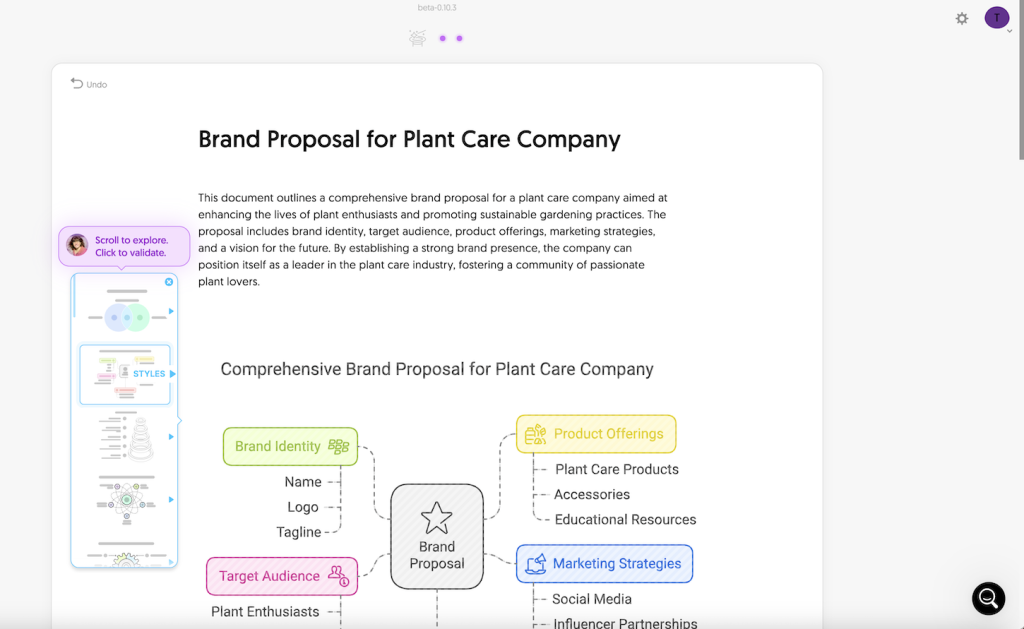
Examples of use: None currently – we’d love submissions of examples.
Key Information:
- Cost: The starter plan is free, and presently the professional plan is free while the tool is in beta. Pricing
- Enterprise version available? Yes, coming soon Pricing
- Privacy and IPR: Yes, Privacy Policy
- GDPR statement? Yes looks so, Privacy Policy
- Accessibility statement or guidance: No
- Age Restrictions: 13+ (Privacy Policy)
- AI Team? Yes, it’s a great tool, really useful and good at transforming text or concepts into various charts, especially if the concept is well-structured
(entry created 27 January 2025)
Skybox 360
Description: Skybox AI is a 360° image generator from Blockade Labs.
Getting Started: Get started by going to the Blockade Labs website here there will be a sample prompt that you can generate content from, or you can explore more existing Skyboxes for inspiration.
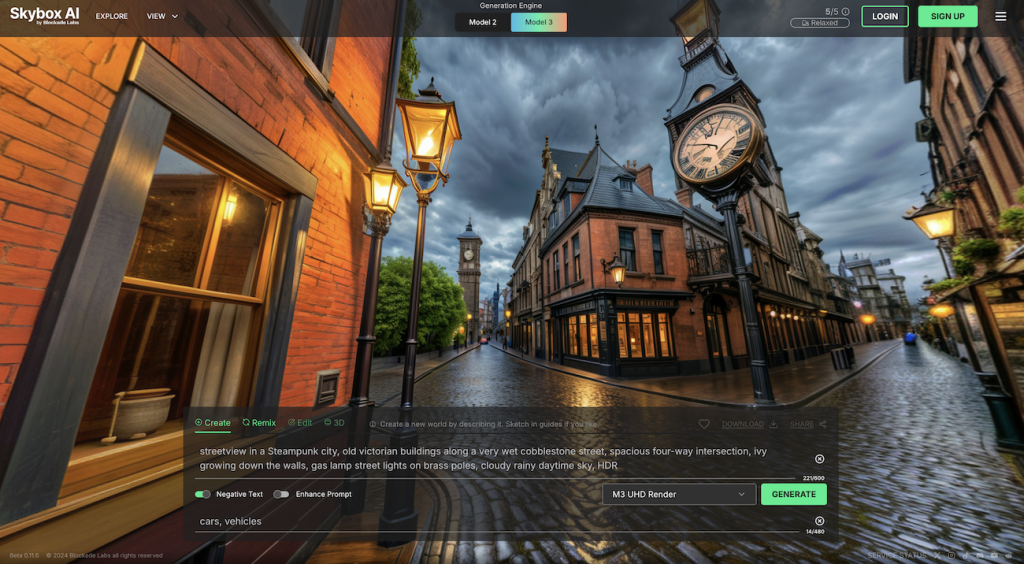
Examples of use:
Key Information:
- Cost: A free account allows for 15 generations per month, paid accounts provide higher prompt allowances and additional features starting at $12 a month.
- Enterprise version available? Yes, contact Blockade Labs for pricing on application.
- Privacy and IPR statement? Yes, see Blockade Labs Privacy policy
- GDPR statement? Yes,
- Accessibility statement or guidance: No
- Age Restrictions: 18+, see Blockade Labs terms of service for more details
- Tried by Jisc’s AI Team? Yes, tested and used by AI team.
(Entry created 28 August 2024)
SlideSpeak
Description: AI tool to create PowerPoint presentations with AI, design presentation slides, or summarise an entire presentation. Powered by ChatGPT.
Getting Started: Go to the Slidespeak Website and sign up for the free demo.
Examples of use: None currently – we’d love submissions of examples.
Key Information:
- Cost: There is a basic free plan, and the Premium Plan is currently $24 ($39) a month, with Premium Plus currently at $29 ($49) a month: Slidespeak pricing.
- Enterprise version available? Yes.
- Privacy and IPR: Yes, Slidespeak privacy
- GDPR statement? Yes, Slidespeak privacy
- Accessibility statement or guidance: No.
- Age Restrictions: 13 Years +
- AI Team? Tested by the Jisc AI team.
(entry created 15 October 2024)
SmartyAI
Description: AI-powered Content Generator.
Getting Started: Go to the Smarty ai website and sign up for an account to get started with the free version.
Examples of use: None currently – we’d love submissions of examples.
Key Information:
- Cost: There is a free version, with a Pro Version at $9.99 pm Smarty ai pricing
- Enterprise version available? Yes, see Smarty ai pricing
- Privacy and IPR: Yes, see Smarty ai privacy
- GDPR statement? Yes, see Smarty ai terms
- Accessibility statement or guidance: None
- Age Restrictions: 13 years +
- Tried by Jisc AI Team? Tested by Jisc AI team.
(Entry created 15 October 2024)
Synthesia
Description: Synthesia is a platform for creating presentation videos delivered by AI avatars.
Getting Started: Users can get started with a free account or by booking a demo with Synthesia themselves. The free account delivers a single editor and 36 minutes of video per annum.
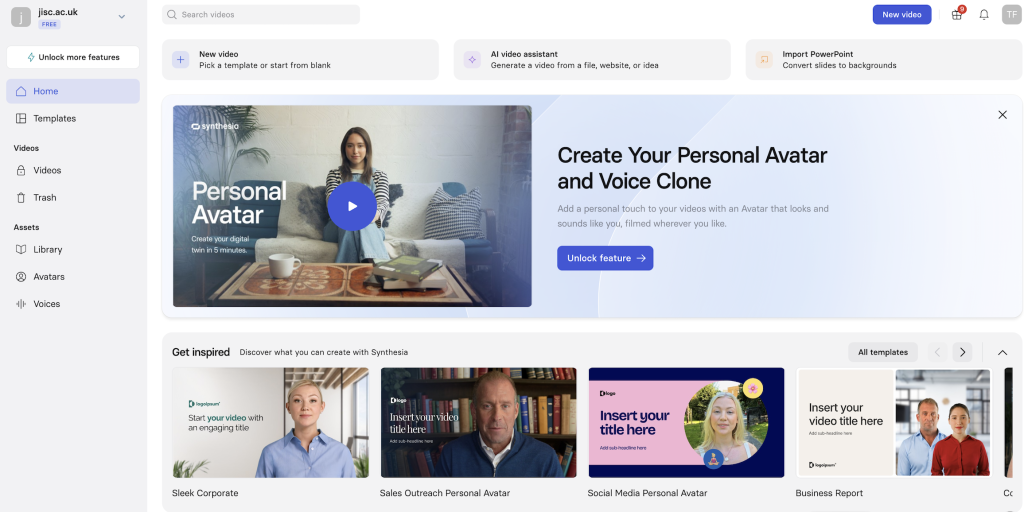
Examples of use:
- Networkshop demo – an example showing communications for a new telephony services. (Jisc)
Key Information:
- Cost: £17pm for a starter account, £52pm for a creator account.
- Enterprise version available? Yes
- Privacy and IPR statement? Yes, see Synthesia’s Privacy Policy
- GDPR statement? Yes, covered in Synthesia’s Privacy Policy
- Accessibility statement or guidance: No statement about Synthesia itself but they do provide guidance on accessible video generation with Synthesia
- Age Restrictions: Services not intended for use by those under 16
- Tried by Jisc’s AI Team? Yes, used by the team with positive results, including translation to other languages.
(Entry created 28 August 2024)
Veed
Description: Veed.io is an easy-to-use, cloud-based video editing platform ideal for beginners and casual users, offering features like auto-subtitling, text overlays, and collaboration tools.
Getting Started: Go to the Veed website and signup for a free account, it will then guide you through creating your first video with them.
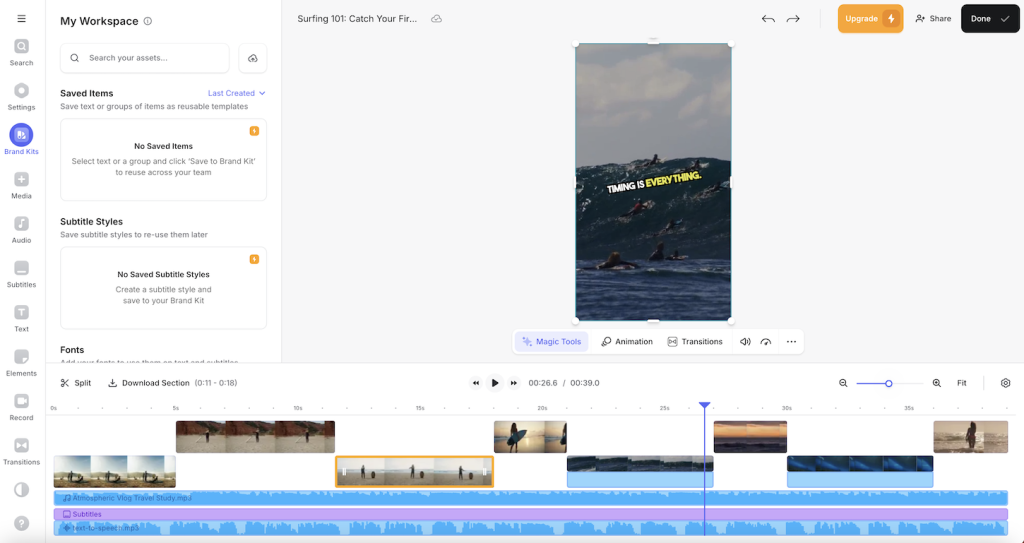
Examples of use: None currently – we’d love submissions of examples.
Key Information:
- Cost: Get started with a free tier, $9 per user per month, or $19 per user per month – Veed Pricing
- Enterprise version available? Yes, Veed Pricing
- Privacy and IPR: Yes , Veed Privacy Policy
- GDPR statement? Yes , Veed Privacy Policy
- Accessibility statement or guidance:
- Age Restrictions: There is no specified age, but Veed states that it is not to be used by children.
- AI Team? Yes, it is a versatile online video editing platform that’s user-friendly and feature-rich, catering to a wide audience.
(entry created 27 January 2025)
Accessibility
Be My Eyes
Description: Be My Eyes is primarily a service which connects sighted volunteers with people who are blind or have low vision for support via a video call. Their AI feature – Be My AI, provides a virtual assistant equivalent powered by GPT-4.
Getting Started: Download the App for iOS, Android & Windows
Examples of use:
- None currently – we’d love submissions of examples.
Key Information:
- Cost: Free for users
- Enterprise version available? Yes, Be My Eyes enterprise Solutions have specialised costings.
- Privacy and IPR statement? Yes, view the Be My Eyes privacy policy
- GDPR statement? No specific mention in privacy policy – Be My Eyes is a US-based service
- Accessibility statement or guidance: No statement specific to Be My AI is available, however, Be My Eyes itself is an assistive technology app.
- Age Restrictions: 18+
- Tried by Jisc’s AI Team? Tested and demonstrated by the team.
(Entry created 28 August 2024)
Freesubtitles.AI
Description: Freesubtitles.ai is an effective tool for transcribing audio and video to text.
Getting Started: Visit the freesubtitles.ai website to get started for free, but some features are restricted to paying users.
Examples of use: None currently – we’d love submissions of examples.
Key Information:
- Cost: You can start for free, and users are encouraged to purchase credits ($0.99/h) if needed.
- Enterprise version available?
- Privacy and IPR: Yes, Privacy Policy
- GDPR statement? Yes, looks so, Privacy Policy
- Accessibility statement or guidance: No
- Age Restrictions:
- AI Team? Yes, it’s a very useful tool.
(entry created 27 January 2025)
Goblin.tools
Description: is a collection of small, simple, single-task tools, mostly designed to help neurodivergent people with tasks they find overwhelming or difficult.
Getting Started: Free – no account required.
Examples of use:
Key Information:
- Cost: Free
- Enterprise version available? No
- Privacy and IPR statement? Yes, view the goblin.tools privacy statement
- GDPR statement? No
- Accessibility statement or guidance: No
- Age Restrictions: None
- Tried by Jisc’s AI Team? We show this as an example of tools to support accessibility in our webinars and events.
(Entry created 28 August 2024)
Google Lens
Description: Google Lens is a set of vision-based computing capabilities that can understand what you’re looking at and use that information to copy or translate text, identify plants and animals, explore locales or menus, discover products, find visually similar images, and take other useful actions.
Getting Started: Download the Google Lens app or go to Google.com and select the Search by Image icon in the search-bar. This brings up the Lens search menu where users can search any image with Google Lens, either by drag-dropping an image or uploading a file, alternatively, you can paste an image link to search.
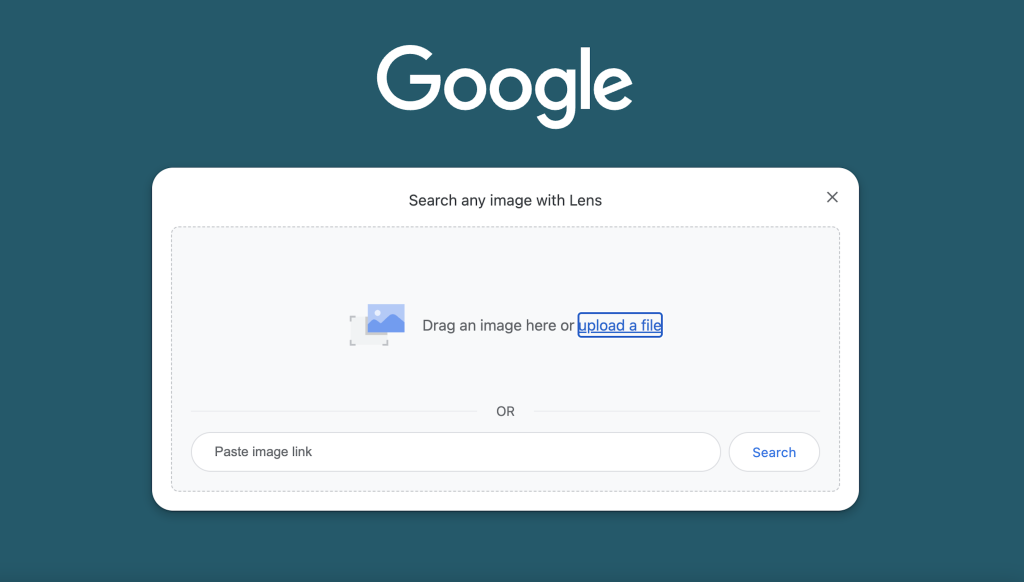
Examples of use:
- None currently – we’d love submissions of examples.
Key Information
- Cost: Free
- Enterprise version available? No
- Privacy and IPR statement? Yes, see Google’s privacy policy
- GDPR statement? Yes, included in Google’s privacy policy
- Accessibility statement or guidance: Yes, see Google’s accessibility guidance
- Age Restrictions: 18 years for those with Google account, with restrictions for those under 18. 17yrs+ on the App store.
- Tried by Jisc’s AI Team? Yes, tested and used by AI team members.
(Entry created 28 August 2024)
Grammarly
Description: AI platform which reviews spelling, grammar, punctuation, clarity, engagement, and delivery mistakes in English texts, detects plagiarism, and suggests replacements for the identified errors.
Getting Started: Downloading Grammarly is free and works across a variety of platforms. It also has browser plugins and these are accessible on their application site.
Examples of use:
Key Information
- Cost: Free access, with subscriptions available.
- Enterprise version available? Yes, see Grammarly pricing plans
- Privacy and IPR statement? Yes, see Grammarly’s privacy policy
- GDPR statement? Yes, included in Grammarly’s privacy policy
- Accessibility statement or guidance: Yes, see Grammarly’s accessibility statement
- Age Restrictions: 16+ – see Grammarly Terms and Conditions for details
- Tried by Jisc AI Team? Yes, tried and used extensively by many members of the team.
(Entry created 28 August 2024)
Microsoft Immersive Reader
Description: Microsoft’s Immersive Reader is a free tool, built into Word, OneNote, Outlook, Office Lens, Microsoft Teams, Reading Progress, Forms, Flip and the Edge browser, that implements proven techniques to improve reading and writing.
Getting Started: This can be accessed in any of the Microsoft 365 apps listed above, for example here is a guide to accessing Immersive Reader in Word.
Examples of use:
- None currently – we’d love submissions of examples.
Key Information
- Cost: Free
- Enterprise version available? Available as part of the Microsoft 365 suite
- Privacy and IPR statement? Yes, see Microsoft’s privacy statement
- GDPR statement? Yes, included in Microsoft’s privacy statement
- Accessibility statement or guidance: Microsoft has general accessibility resources for their tools
- Age Restrictions: There is no specific age restriction to use Immersive Reader, but users need to be 13+ to create a Microsoft Office 365 account unless their parents create them a child-friendly account.
- Tried by Jisc’s AI Team? Yes, has been tested out by the Jisc AI team.
(Entry created 28 August 2024)
Microsoft Seeing AI
Description: Seeing AI app from Microsoft Seeing AI is a free app that narrates the world around you. Designed for the blind and low-vision community, this research project harnesses the power of AI to describe people, text, currency, colour, and objects.
Getting Started: Download the app for iOS or Android through the SeeingAI website.
Examples of use:
- None currently – we’d love submissions of examples.
Key Information:
- Cost: Free, doesn’t require account creation
- Enterprise version available? No
- Privacy and IPR statement? Yes, see Microsoft’s privacy statement
- GDPR statement? Yes, included in Microsoft’s privacy statement
- Accessibility statement or guidance: Microsoft has general accessibility resources for their tools
- Age Restrictions: None
- AI Team? Yes, tested out by the Jisc AI team.
(Entry created 28 August 2024)
Microsoft Speaker Coach
Description: With a focus on public speaking, Speaker Coach uses innovative technology that automatically analyses a speaker’s communication style and helps them present information more effectively. Integrated into MS Teams & PowerPoint.
Getting Started: Turn on Speaker Coach in Microsoft Teams or PowerPoint
Examples of use:
- None currently – we’d love submissions of examples.
Key Information
- Cost: Free preview, even without an Office subscription.
- Enterprise version available? Yes, included in Microsft 365 enterprise versions
- Privacy and IPR statement? Yes, see Microsoft’s privacy statement
- GDPR statement? Yes, included in Microsoft’s privacy statement
- Accessibility statement or guidance: Microsoft has general accessibility resources for their tools
- Age Restrictions: 13 years to have a Microsoft Account.
- Tried by Jisc’s AI Team? Yes, tested in both Teams & PowerPoint by the Jisc AI Team.
(Entry created 28 August 2024)
Speechify
Description: Speechify is a web, desktop & mobile app, as well as a browser extension that reads text aloud using a computer-generated text-to-speech voice. The app also uses optical character recognition technology to turn physical books or printed text into audio.
Getting Started: Go to their website and choose your medium for using the application. To get started quickly you can go to Speechify’s text-to-speech online page to use the web application. You may be prompted to create a free account to gain more access.
Examples of use:
- None currently – we’d love submissions of examples.
Cost:
- Enterprise version available? Yes, contact Speechify for pricing
- Privacy and IPR statement? Yes, see Speechify’s privacy policy
- GDPR statement? Yes, covered in Speechify’s privacy policy
- Accessibility statement or guidance: No
- Age Restrictions: 18 years + see Speechify terms of service for more details
- Tried by Jisc’s AI Team? Yes, tested as a tool by the Jisc AI team.
(Entry created 28 August 2024)
Research and Analysis
Annif
Description: Annif is an open-source tool for automated subject indexing developed at the National Library of Finland. Annif uses a combination of existing natural language processing and machine learning tools, is multilingual and can support any subject vocabulary.
Getting Started: There is a free demo on their website, and there is a tutorial on the use of Annif on their Github page (opens a new tab). There is also an introductory video on their YouTube.
Examples of use: None currently – we’d love submissions of examples.
Key Information:
- Cost: A free plan is available with 100 credits per month, then it is 9 € (Scholar package) per month or 59.9 € per month for a team subscription
- Enterprise version available? Team subscriptions are 59.9 € per month.
- Privacy and IPR: Yes, Helsinki University data protection
- GDPR statement? Yes, Helsinki University data protection
- Accessibility statement or guidance: Yes, annif accessibility page
- Age Restrictions: None
- AI Team? Yes, it is a very useful tool for transcribing and searching through documents.
(Entry created 26 November 2024)
Audemic
Description: Audemic Scholar enables PhD students and researchers to transform stale research PDFs into a time-saving reading and listening experience. Audemic Insights app summarises open research articles and reports into brief written and audio summaries for the non-academic.
Getting Started: Go to Audemic’s website to start a 7 day free trial.
Examples of use: None currently – we’d love submissions of examples.
Key Information:
- Cost: £16 per month – Audemic pricing
- Enterprise version available? No
- Privacy and IPR: Yes, see Audemic’s Privacy policy
- GDPR statement? Yes, see Audemic’s Privacy policy
- Accessibility statement or guidance: None.
- Age Restrictions: 18 years + see Audemic’s terms and conditions
- AI Team? Tested by multiple members of the team.
(Entry created 15 October 2024)
Consensus
Description: An AI Search Engine for Research.
Getting Started: Go to Consensus Website and either sign up or try out some of the demos without doing so.
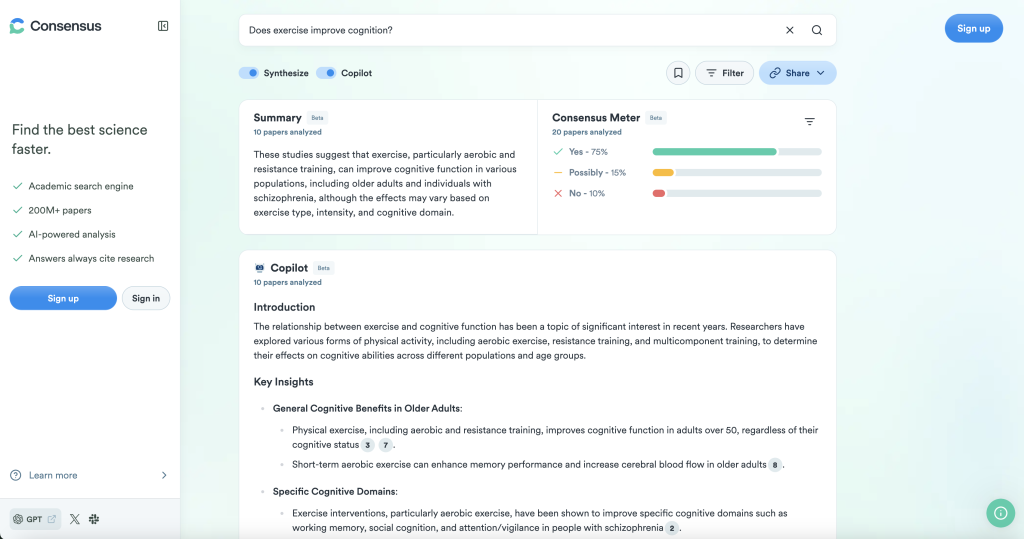
Examples of use: None currently – we’d love submissions of examples.
Key Information:
- Cost: Free version, $8.99 pm for pro, $9.99 pm for Teams: Consensus pricing (40% discount for students)
- Enterprise version available? Yes, Consensus Pricing/
- Privacy and IPR: Yes, Consensus Privacy Policy
- GDPR statement? None.
- Accessibility statement or guidance: None
- Age Restrictions: 18+
- Tried by Jisc AI Team? Tested and demonstrated to the team.
(Entry created 14 October 2024)
Cubby
Description: An AI workspace built for collaborative research, Cubby is an AI tool that summarises, generates content, and organizes notes, enabling users to turn content into actionable, polished materials with minimal effort. Note that this tool appears to still be in a level of beta and the details below may change.
Getting Started: To get started with Cubby, sign up on their website to gain access and follow the instructions to create your first workspace and get started.
Examples of use: None currently – we’d love submissions of examples.
Key Information:
- Cost: Users can sign up on a weeks free trial of Cubby, once this is ended billing is at $16 per month as per cubbys pricing page
- Enterprise version available? Unclear at present as the tool is still in a level of beta.
- Privacy and IPR: Yes Privacy policy
- GDPR statement? Yes Privacy policy
- Accessibility statement or guidance: No.
- Age Restrictions: 16 years + outside of the US (cubby terms-of-service)
- AI Team? Yes, a very good collaborative workspace tool.
(entry created 10 January 2025)
Elicit
Description: Elicit is a research tool that helps users quickly find, summarise, and compare academic papers, answer questions about studies, organise references, identify research gaps, and generate hypotheses, making it ideal for researchers and students managing complex literature.
Getting Started: Sign up on Elicit’s website to gain access to the tool. Once logged in, you can begin by typing a research question or topic into the search bar. Elicit will then fetch relevant research papers and provide summaries, key insights, and comparisons.
- Examples of use: None currently – we’d love submissions of examples.
Key Information:
- Cost: Elicit offers a free basic version with core features, while paid subscriptions provide additional tools, with Plus membership at $10 and Pro at $42 per month. See Elicit’s Website for more info.
- Enterprise version available? Yes, contact Elicit for pricing
- Privacy and IPR statement?: Yes, Elicit’s Privacy Policy
- GDPR statement? Yes, there is no specific statement on their website or privacy policy about GDPR compliance. However, it states in their policy that in some regions (like the European Economic Area), users have certain rights under applicable data protection laws.
- Accessibility statement or guidance: No
- Age Restrictions: 13+
- Tried by Jisc’s AI Team? Yes, has been tested out by the Jisc AI team.
(Entry created 11 September 2024)
Explorance MLY
Description: Explorance MLY is a platform which utilises AI for qualitative analysis using machine learning models made bespoke for analysing the student experience.
Getting Started: To get started with Explorance MLY you can reach out to them to arrange a demo via their website.

Examples of use:
- MLY Product Notes – Jisc
Key Information:
- Cost: To enquire about pricing for your institution contact Explorance.
- Privacy and IPR: Yes, refer to the terms of use link at the bottom of the MLY product page
- GDPR statement? Yes, refer to the terms of use link at the bottom of the MLY product page
- Accessibility statement or guidance: None
- Age Restrictions: None, the product is intended for staff use
- Tried by Jisc’s AI Team? Yes, Product notes are here Explorance MLY
(Entry created 28 August 2024)
Research Rabbit
Description: Research Rabbit is a “citation-based literature mapping tool” available online which aims to optimise a user’s time by searching for references as they plan their essay, minor project, or literature review. Users can create graphs and visualise their data and ‘interactions’.
Getting Started: Go to Research Rabbit’s website and sign up.
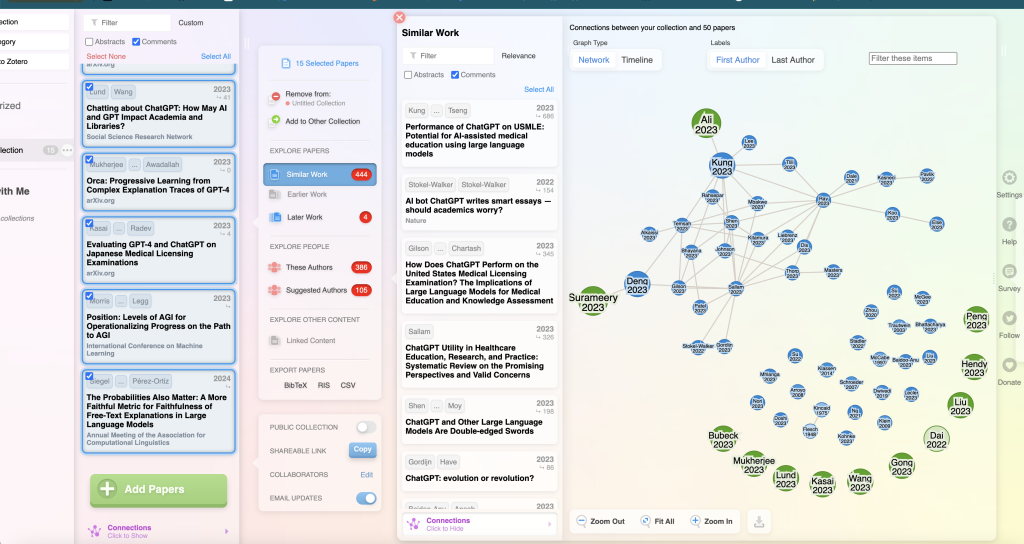
Examples of use: None currently – we’d love submissions of examples.
Key Information:
- Cost: Free – see Research Rabbit’s website
- Enterprise version available? No
- Privacy and IPR: Yes, see Research Rabbit’s Privacy policy
- GDPR statement? Yes, see Research Rabbit’s Privacy policy
- Accessibility statement or guidance: None.
- Age Restrictions: 18+, see Research Rabbit’s Privacy policy
- AI Team? Tested by multiple members of the team.
(Entry created 14 October 2024)
Student Voice
Description: Student Voice provides a service which uses a series of bespoke machine learning models to analyse student feedback automatically.
Getting Started: You can request a demo from Student Voice.
Examples of use:
- Student Voice pilot – Jisc
Key Information:
- Cost: Priced individually, contact Student Voice for a quote
- Privacy and IPR statement?: Contact Student Voice directly for information
- GDPR statement? Contact Student Voice directly for information
- Accessibility statement or guidance: No specific statement, contact Student Voice directly for accessibility information
- Age Restrictions: None, the product is intended for staff use
- Tried by Jisc’s AI Team? Piloted by Jisc AI Team, read the Student Voice pilot report
(Entry created 28 August 2024)
Professional Services
Decisions
Description: Decisions is a meeting management tool that integrates with Microsoft 365. It offers features such as an agenda builder, minutes templates, action item capture, and AI tools for creating agendas, recaps, and minutes.
Getting Started: There are two options. Go to their website and choose Get Decisions for Teams. You can also access it via MS Teams as an add-in option.
Examples of use: None currently – we’d love submissions of examples.
Key Information
- Cost: Available on site.
- Enterprise version available? Yes, contact Decisions for pricing.
- Privacy and IPR statement? Yes, see Decision’s privacy policy
- GDPR statement? Yes, covered in Decision’s compliance policy.
- Accessibility statement or guidance: No.
- Age Restrictions: No.
- Tried by Jisc’s AI Team? Yes, tested as a tool by the Jisc AI team.
(Entry created 19 December 2024)
Chore
Description: AI powered admin tool to manage HR, Finance, Compliance and Equity.
Getting Started: Go to Chore’s website and book a demo with them.
Examples of use: None currently – we’d love submissions of examples.
Key Information:
- Cost: Pricing is unavailable on their website and seems to be made to measure from a call with their sales department as per their faqs
- Enterprise version available? Pricing is unavailable on their website and seems to be made to measure from a call with their sales department as per their faqs
- Privacy and IPR: Yes , Privacy Policy
- GDPR statement? No, Privacy Policy
- Accessibility statement or guidance:
- Age Restrictions: 18+ as per Terms and Conditions
- AI Team? No, no demo available without consultation with Chores sales department but an interesting tool which is getting a lot of coverage in the US.
(entry created 10 January 2025)
Search Tools
Perplexity AI
Description: Perplexity AI is an AI-powered search engine designed to give users answers to their queries from the web. It works as a hybrid between ChatGPT and Google, offering real-time insights, content generation, and deep research capabilities.
Getting Started: Visit Perplexity AI, create an account and start searching. You can use it to ask questions and cite answers so that users can verify the sources. More information is available here Perplexity AI Getting Started
Examples of use: None currently – we’d love submissions of examples.
Key Information:
- Cost: You can start for free, and users can upgrade to a pro account for Perplexity AI Pro
- Enterprise version available? Yes, more details are available here Perplexity AI Enterprise
- Privacy and IPR: Yes, Privacy Policy
- GDPR statement? Yes, Privacy Policy
- Accessibility statement or guidance: No
- Age Restrictions: 13 years + ai terms of service
- AI Team? Yes, it’s a very useful tool for searching and is one we have watching for a while
(entry created 03 February 2025)
Skills and Training
Readwise
Description: Readwise is an application that allows users to revisit and learn from their highlighted articles and ebooks using a process called ‘Spaced Repetition’ to encourage memorisation.
Getting Started: To get started, go to readwise.io and click get started to join their free trial for 30 days.
Examples of use: None currently – we’d love submissions of examples.
Key Information:
- Cost: Billed as $12.99 pm and there is a 50% academic discount. This is $9.99 pm if paid annually.
- Enterprise version available? No, but discounts for members of Non-profits and Academic Institutions.
- Privacy and IPR: Yes, Readwise privacy policy.
- GDPR statement? Yes, Readwise privacy policy.
- Accessibility statement or guidance: No.
- Age Restrictions: 16+
- AI Team? Tried as a demo, this works well as a tool
(entry created 20 January 2025)
Change Log
-
-
- Version 1.1 – Added Elicit and Tutello.
- Version 1.2 – Added Blackboard, Audemic, Research Rabbit, Consensus, SlideSpeak, SmartieAI.
- Version 1.3 – Added Bril AI, Raffle AI, Keath AI. Updated ChatGPT, Claude, Poe, LearnWise, Adobe Firefly, Canva, Teachermatic, Audemic, Consensus, Jamworks.
- Version 1.4 – Added Taskbase, Annif, Mistral Le Chat, HeyGen
- Version 1.5 – Added Google Notebook LM, Decisions, Updated Github Copilot.
- Version 1.6 – Added Cubby & Chore.
- Version 1.7 – Added Readwise, Freesubtitles, Veed, Guidde, Napkin AI & Perplexity.
-
Contributors:
Tim Finch, Helen Nicholson, Michael Webb, Tom Moule, Manya Sikombe, Sue Attewell

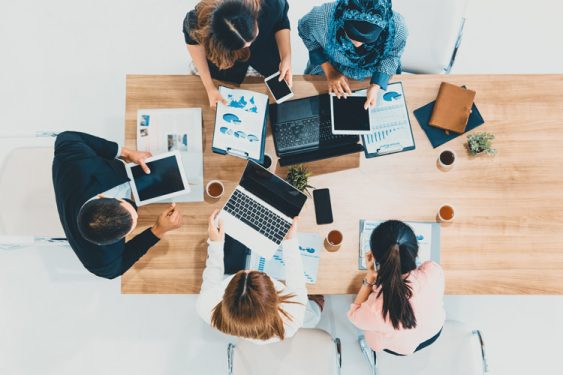
3 replies on “AI Tools”
I’ve been exploring with Claude 3.5 Sonnet, free plan, supporting my Physics teaching for future teachers and engineers. Could this kind of use be of interest for tour objectives?
Hi Claudio,
Thanks for responding, we would really be interested in your use of Claude 3.5 Sonnet and would love to hear more. Would you please be able to send over the information to AI@jisc.ac.uk
Notebook LM would be a great aide for revision in school but students can’t use it due to them being under 18, despite parental consent being given. It’s a shame Google haven’t put something in place that allows those under 18 to use it on managed accounts.